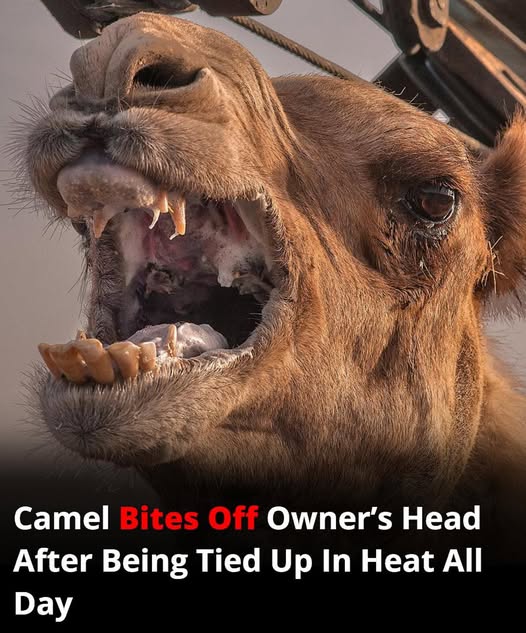
In a shocking and tragic incident that unfolded in the Barmer district of Rajasthan, India, a neglected camel turned on its owner after being tethered for hours under extreme heat without water or shade. The 2016 event serves as a grim reminder of the consequences of animal mistreatment and underscores the importance of responsible ownership.
The Incident
The Barmer district, part of India’s arid Thar Desert, is known for its scorching temperatures, which often exceed 109°F (43°C). On this fateful day, the mercury soared past 120°F (49°C), creating unbearable conditions for both humans and animals alike.
Urjaram, the camel’s owner, reportedly left the animal tied up outside his home while entertaining guests indoors. With its legs bound and no access to water or shelter, the camel endured hours of relentless sun exposure. Witnesses described the distressed animal pacing, growling, and showing clear signs of agitation—a desperate cry for help ignored by those around him.
When Urjaram eventually stepped outside to untie the camel, the pent-up frustration and suffering exploded into violence. In a fit of rage, the camel attacked its owner, grabbing him by the neck, throwing him to the ground, and biting into his body with crushing force. The attack was so severe that the camel reportedly severed Urjaram’s head, leaving villagers stunned and horrified.
It took nearly six hours and the combined effort of 25 people to subdue the frenzied animal, using ropes and a truck to drag it away from the gruesome scene. Locals claimed this wasn’t an isolated clash; tensions between Urjaram and the camel had reportedly been brewing for some time, culminating in this devastating outburst.
Camels: Gentle Giants or Unpredictable Beasts?
While camels are traditionally revered for their loyalty, endurance, and ability to thrive in harsh desert environments, they are not immune to stress or provocation. Known as “ships of the desert,” these majestic creatures have long supported human livelihoods through transportation, trade, and agriculture. However, beneath their calm demeanor lies immense strength and power.
Experts warn that when pushed beyond their limits—whether through neglect, abuse, or mishandling—camels can become dangerously unpredictable. Weighing up to 2,200 pounds, camels possess muscular jaws capable of inflicting catastrophic injuries. Their powerful kicks, delivered forwards or backwards, and their ability to crush objects with their weight make them formidable opponents.
A camel behavior specialist explained, “A full-grown adult camel can fit your head, arm, leg, or torso in its mouth. They have enough strength to crush limbs and necks while simultaneously kicking and kneeling to pin you down.” This combination of brute force and defensive instincts makes camels particularly dangerous when provoked.
Global Incidents of Camel Attacks
This wasn’t the first time a camel has retaliated against its handler. Similar incidents have occurred worldwide, highlighting the potential dangers of mishandling these animals:
Siberia, 2023: A Bactrian camel trampled its owner to death at a children’s holiday camp after being struck in the face during a dispute over reins. Local reports stated, “The animal did not appreciate such treatment.”
Mexico, 2022: Richard Mileski, the owner of a wildlife sanctuary, was fatally injured when a camel kicked, bit, and ultimately sat on him, causing fatal asphyxiation.
Petting Zoo Escape, 2022: Two men attempting to recapture an escaped camel were cornered and killed. The enraged animal even tried to attack paramedics as they loaded the victims into an ambulance.
These incidents underscore a pattern: camels, though typically docile, react violently when subjected to cruelty or perceived threats.
Lessons Learned: Animal Welfare and Human Responsibility
The tragedy in Barmer raises critical questions about animal welfare and ethical treatment. Camels, like all living beings, require care, respect, and humane handling. Leaving an animal tied up in blistering heat without water or shade is not only inhumane but also reckless, given the predictable outcomes of such neglect.
Animal rights advocates emphasize the need for education and awareness campaigns targeting rural communities where livestock plays a vital role in daily life. Providing proper shelter, hydration, and medical care should be non-negotiable responsibilities for anyone owning animals.
Moreover, experts suggest fostering mutual respect between humans and animals. Understanding behavioral cues—such as pacing, growling, or restlessness—can prevent escalations before they turn deadly. Training programs for handlers could further mitigate risks associated with working closely with large, powerful animals.
Conclusion
The story of Urjaram and his camel is a sobering tale of neglect leading to irreversible tragedy. It reminds us that animals, regardless of their size or temperament, deserve compassion and dignity. As stewards of the natural world, humans must prioritize ethical practices and recognize the intrinsic value of all living creatures.
By addressing issues of animal welfare and promoting responsible ownership, we can prevent future tragedies and foster harmony between humans and the remarkable species we share our planet with. Let this harrowing incident serve as a wake-up call—a plea for kindness, understanding, and accountability in our interactions with the animal kingdom.